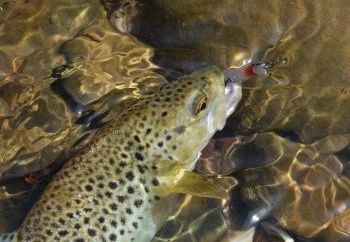Bushfire fish response plan


In the summer of 2019-20 Victoria experienced the worst bushfire season on record with more than 1.2 million hectares burnt through East Gippsland and alpine regions of the North East.
Subsequent rains are washing large loads of ash, sediment and debris into rivers and this runoff impacts water quality. High sediment loads degrade fish habitat and clog fish gills.
Decomposing organic material can reduce dissolved oxygen levels in waterways and some fish kills have been reported downstream of bushfire affected areas.
VFA continues to work with partner Natural Resource Management (NRM) agencies and recreational fishers to monitor bushfire related impacts on fish.
Key information is fed into State and Federal ‘whole of government’ bushfire recovery planning processes. We will also assess the feasibility of salvaging fish likely to be impacted or conduct other targeted fisheries management actions that could assist populations recover if required.
By working closely with local fishing clubs and businesses we will encourage fishers to return to bushfire affected areas once they recover . The recent golden tag competition is one such initiative to encourage recreational fishers to return to East Gippsland and North East Victoria.
Response Plan
- Fisheries Officers to work closely with local NRM partner organisations (NSW DPI, CMA’s, DELWP, Parks Victoria and EPA) to understand those waterways affected by bushfire related run-off. This information will be provided to senior managers for action. The focus of this monitoring will be to inspect affected waterways and, where it is safe to do so, identify potential opportunities for fish salvage.
- In response to the above, the we will assess the feasibility of fish salvage operations and logistics. We will share this information with relevant recovery planning processes. If feasible, we may partner with other organisations to facilitate and resource fish salvages.
- We will keep recreational fishers up-to-date on our response actions through social media and through VRFish, Australian Trout Foundation, Native Fish Australia and FutureFish, plus other fishing clubs.
- When safe to do so and in collaboration with local recreational fishing organisations and businesses, we will promote fishing visitation to bushfire affected areas.
- We will prioritise future stocking at locations where fish kills have occurred when conditions can support fish and where stocking is identified as likely to help fish populations recover.'
Update 8 July 2020
On 9 June 2020 a meeting was held between VFA, local anglers and representatives from the Australian Trout Foundation, Native Fish Australia, VRFish and the North East CMA to discuss the recovery of river systems and fisheries in north east Victoria.
Encouragingly some signs of recovery are evident. Meeting attendees agreed on the following actions:
1. Conduct a baseline fish population survey of Corryong/Nariel Creek, Cudgewa Creek and Thowgla Creek.
- The survey will make observations of habitat and food sources suitable for fish recruitment (stocked or natural)
- The survey will be co-funded by VFA, North East CMA and the Australian Trout Foundation.
2. Conduct fish stocking trials later this year to investigate if fish population recovery can be accelerated though stocking. Locations include:
- Nariel Creek, upstream of McNamara’s Bridge – stocked with wild trout fry sourced from NSW Gaden hatchery (genetically distinguishable from resident trout)
- Corryong and Cudgewa Creeks – stock fingerling Murray cod
- Thowgla Creek – unstocked (to be used as a control site to follow natural recovery)
The survey and fish stocking trials will involve anglers and the results will be shared through Talk Wild Trout Conference, Murray Codference and social media.
Update 27 May 2021
Baseline fish population surveys of Corryong/Nariel Creek, Cudgewa Creek and Thowgla Creek have been conducted.
Baseline surveys of the Nariel Creek recorded no trout.
Baseline surveys of Thowgla Creek recorded two trout, one was a juvenile young-of-vear trout that indicated some respawning had occurred following the bushfires.
Baseline surveys of Corryong and Cudgewa Creek yielded several Murray cod, but the numbers were low indicating the streams in recovery mode.
Fish stocking has since occurred in the following waters:
- Nariel Creek 18,500 first feeding brown trout fry on 18th November 2020
- Corryong Creek 12,500 Murray cod on 18th December 2020
- Cudgewa Creek 12,500 Murray cod on 18th December 2020
Follow up surveys post stocking were completed in April 2021 with trout sampled for genetic analysis. The survey results will be shared through Talk Wild Trout Conference, Murray Codference and social media.
Macquarie perch
The Buffalo River supports an important population of Macquarie perch.
The Buffalo catchment was severely impacted by the fires and surveys were conducted to assess the how the population responded and if there were any management actions required. Click here to view the survey results.
Macquarie perch were found in low numbers.
An emergency fish salvage operation was undertaken by DELWP (Arthur Rylah Research Institute) immediately following the fires, to remove some Macquarie perch from the post fire threats and the fish were subsequently returned in June 2020 once the water quality had improved.
In March, 12,000 Macquarie perch fingerlings were stocked into the Buffalo River to further support the impacted population.
For further information, please email john.douglas@vfa.vic.gov.au
